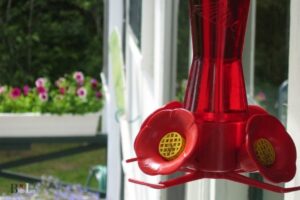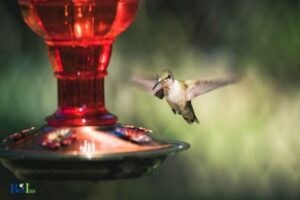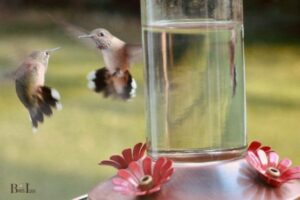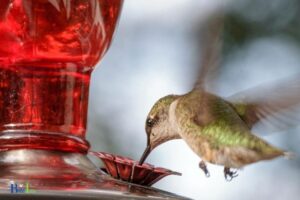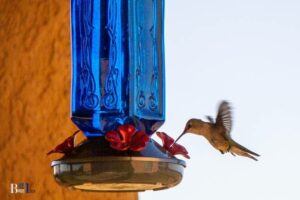Best Thing To Feed Hummingbirds: A Complete Guide
Homemade sugar water solution is the best thing to feed hummingbirds.
The best thing to feed hummingbirds in your garden is a homemade sugar water solution, closely mimicking the natural nectar they feed on.
By combining one part sugar with four parts water, the solution closely mimics natural nectar, providing essential energy for their high metabolism.
The sugar and water ratios can be adjusted to meet the needs of different hummingbird species.
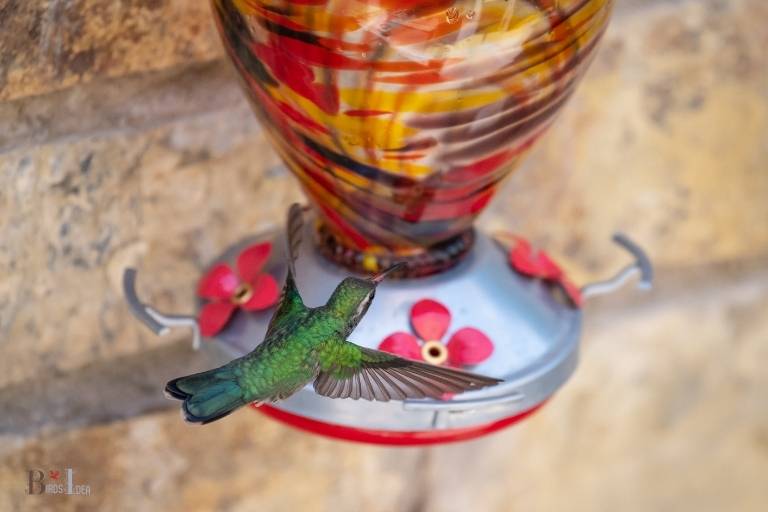
5 Food Source: Things To Feed Hummingbirds
| Food Source | Description | Benefits | Notes |
|---|---|---|---|
| Sugar Water | A mixture of sugar and water, typically in a 4:1 ratio (4 parts water, 1 part sugar) | Provides energy and mimics natural nectar | Change the mixture every 2-3 days, or more frequently in hot weather |
| Artificial Nectar | Commercially available nectar, usually in powder or liquid form | Convenient and easy to use | Choose a product without added dyes or preservatives |
| Native Flowers | Planting native flowers in your garden to attract hummingbirds | Provides natural nectar, pollen, and insects for a balanced diet | Choose flowers with tubular shapes and red, orange, or pink colors |
| Insects | Insects such as fruit flies, ants, and spiders are part of a hummingbird’s diet | Provides essential proteins and nutrients | Not a direct food source to provide, but can be found naturally in gardens with native plants |
| Fruit | Small pieces of soft fruit such as oranges, watermelon, or grapes | Attracts fruit flies, which hummingbirds eat | Place fruit in a separate feeder or container to avoid contamination of other food sources |
How to Make a DIY Hummingbird Feeder?
Creating a DIY hummingbird feeder is a simple and cost-effective way to attract these beautiful birds to your garden. Homemade feeders can be just as appealing as store-bought ones while providing a sustainable source of food for hummingbirds.
To make a DIY hummingbird feeder, follow the steps below:
- Gather materials: You will need a clean, empty plastic bottle with a lid, a red plastic or fabric flower, a small plastic bowl or container, a piece of flexible metal or plastic tubing, and a string or wire for hanging the feeder.
- Drill a hole in the bottle lid: Use a small drill bit to create a hole in the center of the bottle lid, just big enough for the tubing to fit through.
- Attach the tubing: Insert the tubing through the hole in the lid and secure it with waterproof glue or silicone sealant. Leave enough tubing on the outside to extend at least an inch below the lid.
- Attach the flower: Using glue or silicone, attach the red flower to the tubing’s end, below the bottle cap. This will act as a visual attractant for hummingbirds and a feeding port.
- Create a hanging mechanism: Attach a string or wire to the neck of the bottle, forming a loop for hanging the feeder.
- Fill with nectar solution: Mix one part sugar with four parts water in a saucepan and bring to a boil. Allow the mixture to cool before filling the bottle with the nectar.
- Attach the bottle to the base: Attach the bottle with the lid and flower to the small plastic bowl or container. This will catch any drips and provide a landing area for hummingbirds.
- Hang and enjoy: Hang your homemade hummingbird feeder in a shady spot near your garden, preferably near colorful, nectar-producing flowers. Replace the nectar every 4-5 days and clean the feeder regularly to prevent mold and bacteria growth.
By following these steps, you’ll enjoy the sight of hummingbirds visiting your garden while providing them with a sustainable source of nourishment.
“Hummingbirds need a diet that is high in energy, consisting of mainly nectar and insects.”
– Birds & Blooms Magazine
What Are the Benefits of Feeding Hummingbirds?
Feeding hummingbirds can be a rewarding and enjoyable activity for nature enthusiasts.
These tiny, energetic creatures are not only fascinating to watch, but they also play a vital role in pollination, helping plants to thrive.
By providing a reliable food source, you can help ensure the survival of these beautiful birds, and contribute positively to your local ecosystem.
Benefits of feeding hummingbirds:
- Attract a variety of hummingbird species to your garden
- Aid in pollination, benefiting both plants and the ecosystem
- Provide a reliable food source, especially during migration or when natural nectar sources are scarce
- Observe and learn about hummingbird behavior up close
- Contribute to conservation efforts by supporting hummingbird populations
- Enjoy the beauty and energy of these agile birds in your own backyard
Pro Tip: The best thing to feed hummingbirds is a simple sugar water solution, consisting of 4 parts water to 1 part white sugar. Avoid using honey, artificial sweeteners, or food coloring, as these can be harmful to the birds. Make sure to clean and refill the feeder regularly to prevent mold growth and bacterial contamination.
birdsidea
What Is the Best Time to Feed Hummingbirds?
The best time to feed hummingbirds is during their active hours to ensure they get the energy they need to sustain their high metabolism.
Early mornings and late afternoons are the prime times when hummingbirds actively search for food.
However, they will also feed throughout the day, so offering food continuously is beneficial for their well-being.
Providing a steady supply of nectar will ensure they have a reliable source of energy, making your garden a popular destination for these delightful creatures.
- Prime feeding times: Early mornings and late afternoons
- Offer food continuously throughout the day
- Maintain a steady supply of nectar for best results
Pro Tip: Ensure that the nectar in your hummingbird feeder is fresh and clean by replacing it every 2-3 days, especially during hot weather. Additionally, cleaning the feeder regularly will prevent mold growth and keep your visiting hummingbirds healthy.
birdsidea
What Is the Best Way to Attract Hummingbirds to a Feeder?
The best way to attract hummingbirds to a feeder is by offering them a consistent, accessible, and safe source of food. Hummingbirds are attracted to bright colors, so choose a feeder with a vibrant red hue.
Fill the feeder with a homemade nectar mixture, consisting of four parts water to one part white granulated sugar; avoid honey, artificial sweeteners, and red dye.
Regularly clean the feeder and replace the nectar every 2-3 days to maintain freshness.
Place the feeder in a visible location near flowering plants and provide a safe resting spot nearby, such as a small tree or shrub, so the hummingbirds can perch between feedings.
Key tips for attracting hummingbirds:
- Use a bright red feeder
- Fill the feeder with a simple nectar mixture (four parts water to one part sugar)
- Avoid honey, artificial sweeteners, and red dye
- Regularly clean the feeder and replace the nectar every 2-3 days
- Place the feeder near flowering plants
- Provide a safe resting spot nearby
Pro tip: Planting native flowers around your yard can also help attract hummingbirds, as they are naturally attracted to brightly colored, tubular-shaped flowers.
birdsidea
How to Make Homemade Nectar for Hummingbirds?
Feeding hummingbirds with homemade nectar is an excellent way to support these tiny, fascinating creatures by providing them with a consistent energy source in your backyard.
Creating a nectar solution at home is simple and cost-effective, and the best thing to feed hummingbirds is a mixture of sugar and water, which closely mimics natural flower nectar.
Basic Homemade Hummingbird Nectar Recipe:
- 4 cups of water
- 1 cup of white granulated sugar
Steps to Make Hummingbird Nectar:
- Boil the water in a saucepan or kettle. Boiling helps to dissolve the sugar and also eliminates potential contaminants and impurities.
- Add the sugar to the boiling water and stir until it dissolves completely.
- Let the mixture cool to room temperature.
- Fill your hummingbird feeder with the homemade nectar, leaving some space to accommodate the expansion caused by temperature fluctuations.
- Store any unused nectar in the refrigerator for up to two weeks.
Remember, when offering this homemade nectar to hummingbirds, it’s important to maintain the feeder’s cleanliness.
Your feeder should be cleaned every 2-4 days, depending on your area’s temperature, to prevent mold and bacteria growth, which can be harmful to the birds.
Pro Tips:
- Do not use honey, brown sugar, or artificial sweeteners, as these can be harmful to hummingbirds.
- There is no need to add food coloring, as the feeders often have colorful designs that are enough to attract the birds.
- Provide multiple feeders to avoid overcrowding and territorial aggression among hummingbirds.
- Place your feeders in shaded areas to keep the nectar fresher for longer.
With this simple homemade nectar recipe and proper feeder care, you can create a thriving environment for hummingbirds in your garden and support these beautiful, energetic birds throughout the season.
How to Choose the Right Hummingbird Feeder?
Choosing the right hummingbird feeder is essential to providing a safe and effective source of nourishment for these fascinating creatures.
It’s important to consider aspects like the feeder’s design, materials, ease of cleaning, and proper maintenance. By selecting the best feeder, you can attract and feed hummingbirds and enjoy their beauty in your backyard.
Here’s a bullet point list to consider when choosing the right hummingbird feeder:
- Feeder design: Opt for feeders with bright red or orange colors, as these hues naturally attract hummingbirds. Select a design with multiple feeding ports to accommodate multiple birds at once.
- Materials: Choose a feeder made of durable materials, such as glass, plastic, or metal, ensuring that it can withstand outdoor conditions and last for a long time.
- Ease of cleaning: Regular cleaning is critical to prevent mold and bacteria growth. Choose a feeder that is easy to take apart, clean, and reassemble.
- Capacity: Depending on the number of hummingbirds visiting your backyard, select a feeder with the appropriate capacity. For a few birds, a smaller feeder is suitable; for a more crowded environment, opt for a larger feeder.
- Leakage prevention: Look for a feeder with an anti-drip mechanism to prevent leaks and keep the nectar fresh.
- Accessibility: Ensure that the feeder can be hung or placed in a location easily accessible to both birds and your cleaning routine.
- Safety: Select a feeder with perches or wide openings to prevent birds from getting their beaks trapped.
By considering these factors and keeping the feeder properly maintained, you’ll be able to provide a reliable and attractive food source for hummingbirds visiting your garden.
How to Clean a Hummingbird Feeder?
Maintaining a clean hummingbird feeder is essential for the health and well-being of these delicate birds. A clean feeder can help prevent mold growth and the spread of diseases among hummingbirds.
Here is a step-by-step guide on how to clean a hummingbird feeder properly:
- Empty the feeder: Carefully pour out any remaining nectar from the feeder.
- Disassemble the feeder: Take apart the various components of the feeder to ensure thorough cleaning of each piece.
- Soak in soapy water: Fill a basin with warm, soapy water and submerge the feeder components. This helps loosen any dried nectar or debris.
- Scrub the feeder: Use a soft-bristled bottle brush or toothbrush to gently scrub the components, paying particular attention to corners and crevices where mold can grow.
- Rinse thoroughly: Rinse all components with clean, warm water to remove soap residue and any remaining debris.
- Sanitize with a vinegar solution: Mix a solution of four parts water and one part white vinegar, and soak the feeder components for 10-15 minutes. This helps kill any remaining bacteria or mold.
- Rinse again: Rinse the components once more with clean water to remove any vinegar residue.
- Air-dry: Allow the feeder to air dry completely before reassembling and refilling with fresh nectar.
What Are the Different Types of Hummingbird Feeders?
Hummingbird feeders provide an essential source of nutrition for these fast-flying, energetic birds. They come in various designs, materials, and sizes, ensuring that there is a suitable option for every hummingbird lover.
Here is a list of different types of hummingbird feeders:
- Bottle feeders: These feeders feature a bottle-like container that holds the nectar and typically has a basin with multiple feeding ports. It’s easy to fill, clean, and visually appealing to both humans and hummingbirds.
- Dish feeders: Dish feeders, also known as saucer feeders, have a shallow dish that holds the nectar, covered by a lid with feeding ports. They come in various sizes and colors and are generally easy to clean and maintain.
- Window feeders: Specifically designed to be attached directly to your window, these feeders provide a close-up view of hummingbirds as they feed. They can be either bottle or dish style and have suction cups for secure attachment.
- Decorative feeders: These feeders come in a variety of artistic designs, materials, and colors, making them an attractive addition to any garden or patio. They can be made from glass, ceramic, or metal, and often include unique features like blown glass flowers or intricate metalwork.
Pro Tips:
- Always use a 4:1 mixture of water and white granulated sugar to replicate nectar. Do not use honey, artificial sweeteners, or red dye in the mixture.
- Clean your hummingbird feeder at least once a week to prevent mold and bacteria growth.
- Hang your feeder in a shady spot to keep the nectar fresh for a longer period.
By considering the various types of hummingbird feeders and following these essential tips, you will be able to provide a safe and attractive feeding environment for these beautiful creatures.
Conclusion
In conclusion, the best food to feed hummingbirds is a sugar solution made with four parts water and one part sugar.
It is important to make sure the solution is unsweetened and doesn’t contain any food coloring or honey. Feeding hummingbirds can be a rewarding experience, and it is beneficial for the birds as well.
To attract hummingbirds to a feeder, it is important to place the feeder in a visible and shaded location, and to keep it clean and well-maintained.
DIY hummingbird feeders are easy to make and can be a fun project for bird watchers. By following the tips and advice shared in this article, anyone can create a safe and inviting environment for these beautiful birds to visit.
TL;DR:
- Best food for hummingbirds is a sugar solution made with four parts water and one part sugar
- Feeding hummingbirds is beneficial for the birds and can be a rewarding experience
- To attract hummingbirds, place the feeder in a visible and shaded location, and keep it clean
- DIY hummingbird feeders are easy to make and can be a fun project
“On average, a hummingbird needs to consume twice its body weight in nectar each day to fuel its high metabolism.”
– National Wildlife Federation.
FAQ for Best Thing To Feed Hummingbirds
What is the best food to feed hummingbirds?
Where is the best place to feed hummingbirds?
How often should I feed hummingbirds?
What are the best plants to attract hummingbirds?
What is best to feed hummingbirds?
Hummingbirds are incredible creatures known for their beauty and agility. To maintain their high energy levels, it’s essential to provide them with the proper nutrition.
The best thing to feed hummingbirds is a solution of sugar water.
The recommended ratio is four parts water to one part white table sugar.
Avoid using honey, brown sugar, or any other sweeteners as they hold bacterial properties that can harm hummingbirds.
Moreover, never use any red dye to color the nectar as it is harmful to these delicate creatures. A clean feeder and fresh nectar are necessary to ensure hummingbirds have a balanced diet.
Here are some additional tips you can follow to attract hummingbirds:
- Plant nectar-containing flowers such as bee balm, columbine, and salvia in your garden.
- Place hummingbird feeders near colorful flowers to attract the birds visually.
- Clean your feeder regularly with vinegar and water solution.
- Change the nectar solution every 2-3 days, especially during the hot summer months.
Remember, hummingbirds are delightful guests that make any yard come to life with their vibrant colors and chirping voices. Providing the right kind of nutrition and habitat helps ensure that these cherished birds thrive in your garden.
The Importance of Minerals in a Hummingbird’s Diet: Do They Need Salt?
Hummingbirds are known for being one of the most majestic birds around, and they require specific nutritional needs to thrive.
While most bird feeders and nectar contain a high amount of carbohydrates, minerals, including salt, are essential for hummingbirds too.
Salt helps to maintain an electrolyte balance while supporting healthy muscle function and hydration.
Though hummingbirds only require a small amount of salt, it’s essential to know just how much they need and how to incorporate it into their diet.
Here are some key points to remember about hummingbirds and their salt intake:
- While hummingbirds do require salt, they only require a small amount. Offering too much salt can be harmful to their health and cause dehydration.
- Hummingbirds derive their salt from their diet, and it’s found in natural plant nectars.
- Nectar and bird feeders lack minerals, including salt, so it’s necessary to supplement hummingbirds’ diet with trace amounts of salt.
- Offering hummingbirds saltwater instead of a typical nectar solution can provide them with the necessary minerals they need. A recommended ratio is no more than one teaspoon of salt per gallon of water.
- Hummingbirds prefer water sources with minerals like salt, so offering a shallow dish with a small amount of salt can make your feeder a hotspot for hummingbirds.
It’s essential to remember that balance is key when it comes to hummingbirds’ diet. Providing them with a varied diet is the best way to guarantee they are thriving.
By offering mineral-rich food sources and saltwater, you can help ensure your resident hummingbirds stay vibrant and healthy for years to come.
Can you put too much sugar in sugar water for hummingbirds?
Hummingbirds are attracted to sweet nectar in flowers, making sugar water a great substitute for their diet.
While feeding hummingbirds, one common question that often arises is whether adding too much sugar to the sugar water can be harmful to the hummingbirds. The answer is yes, too much sugar can be harmful to these little birds.
Here are some reasons why too much sugar is not recommended for hummingbirds:
- Hummingbirds may become addicted to sugar and demand it more often.
- It can ferment quickly and harm the bird’s digestive system.
- A high concentration of sugar water can cause dehydration.
- It can lead to bacterial growth, fungal outbreaks, and mold formation.
To avoid such devastating consequences, mix 1 part granulated sugar and 4 parts water and feed the birds sparingly. Additionally, clean the feeder regularly to prevent bacteria formation.
As a hummingbird enthusiast, always remember that feeding these birds comes with great responsibility.
The ultimate goal is to provide a balanced diet, a healthy environment, and a safe feeding area.
- Hummingbirds have a high metabolism rate, and their bodies require up to eight times their weight in food per day.
- During migration, hummingbirds fly over 500 miles without stopping.
- It is difficult for hummingbirds to survive without nectar, and can lead to starvation.
- Putting red food coloring in the sugar water can attract more birds, but it can be harmful to the birds’ health and not necessary.
When it comes to feeding hummingbirds, the main objective is providing a healthy diet and a safe environment.
What feeder attracts the most hummingbirds?
If you want to attract hummingbirds to your yard, one of the best ways to do so is by setting up feeders.
However, not all feeders are created equal when it comes to attracting these beautiful birds.
Additionally, a feeder with multiple ports allows several hummingbirds to feed at once, which can increase the likelihood of attracting more of them.
- Hummingbirds are attracted to bright colors, especially red.
- Bright red feeder bases with yellow flowers are very attractive to hummingbirds.
- A feeder with multiple ports allows several hummingbirds to feed at once, increasing the chances of attracting more of them.
- Avoid feeding hummingbirds with honey, artificial sweeteners, or red food coloring, which can be harmful to them.
To sum up, setting up a red feeder with multiple ports can be a great way to attract hummingbirds to your yard.
How do you make a homemade hummingbird feeder?
Hummingbirds are fascinating creatures that are a delight to watch as they flit and hover around gardens and feeders.
One way to attract these beautiful birds to your yard is by setting up a hummingbird feeder. While there are plenty of commercial hummingbird feeders available in stores, making your own feeder can be a fun and rewarding project that also saves you money.
In this blog post, we will explore how to make a homemade hummingbird feeder that is sure to attract these feathered wonders to your garden.
- Hummingbirds require a diet primarily consisting of nectar for proper nutrition.
- Making your own homemade nectar is easy and cost-effective, using just water and sugar.
- Avoid using honey, artificial sweeteners, or red food coloring in your nectar as they can be harmful to hummingbirds.
- Hummingbirds are only found in the Western Hemisphere, from Alaska to Tierra del Fuego.
- They have a unique ability to hover in place, fly forward, backward and even upside-down due to their rapid wing beats of up to 80 beats per second.

